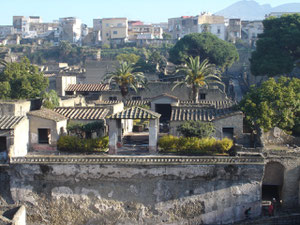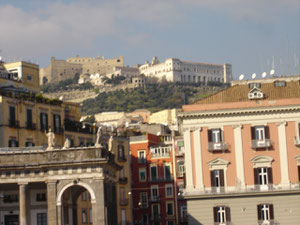follow me in Guided visits and day tours of pompeii, herculaneum and napels

Pompeii
Nowhere else are life and daily routine, economy and handicraft, culture and politics of a Roman town flourishing 2000 years ago more vivid than here. Wide streets and crossings, fountains, houses, splendid villas richly decorated with frescoes and mosaics, gardens, taverns, brothels, bakeries, laundries, stables.
And even more, public squares, markets, temples, baths, theaters, an amphitheater, examples of an efficient sewerage system. A particularly cruel heritage of the natural catastrophe are the very last moments of life of humans and animals captured on plaster casts. With a guided visit you will receive an overall and deep insight in the life of this fascinating antique town.
The most valuables statues, frescoes and mosaics are exposed at the National Museum in Naples. Yet do the in Pompeii remaining originals and copies give an extremely interesting and wide image of Roman art and artisanry up to the first century A.D.

Herculaneum ...
was also buried in 79 A.D. up to 15 meter deep below lava and mud. All forms of life were extinguished in few hours. The discoverers of the 18th century had to dig deep tunnels like in mining to get down to the remains, some of them are still to be seen. Imagine the enormous effort! During a guided tour you will not miss this and many more hidden details.
In Herculaneum the houses, workshops, shops, streets and crossings are even better preserved. We move through once very busy streets, in front of a pistrinum (bakery) we imagine how they milled their own flavour, how clientes (supplicants) were sitting in front of the houses of influential families awaiting to be admitted.
Herculaneum was maybe one third of neighbouring Pompeii, however due to the small excavated area the remains lie closer together and give an immediate, even more plastic image of every-day life 2000 years ago.

Capri
A highly exclusive retreat of the Roman emperors Augustus and Tiberius 2000 years ago, one of the most visited dream islands in the world today. Capri's beauty attracts many people now as then, fills their hearts with genuine joy. Capri is one of the most beautiful spots on earth, a must have seen...
The fascinating Faraglioni rocks seen from the fantastic terrace of the Gardens of Augustus (Giardini di Augusto) as well as the view of the spectacular Via Krupp virtually sticking to the white limestone rock. The special magic under the pergola of Villa San Michele built by Axel Munthe, the strong emotion of the famous Grotta Azzurra (Blue Grotto). Admiring the island walking within crowds of people or discovering it almost on your own staying off the beaten tracks.
As much impressive are the outlying ruins of the imperial Villa Jovis high up on Monte Tiberio, or taking the chairlift to 591 m high Monte Solaro, or island hiking through the lush vegetation on ravishingly beautiful paths with breathtaking views. Capri has so many facets awaiting to be discovered.

Naples
One of the most beautiful views of Naples is from the sea. Can you imagine the fascination of the passengers, when a cruise ship enters the Gulf of Naples and approaches the city. From the harbor you see the imposing fortress of Castel Nuovo and the monumental square of Piazza Municipio. And above them rise the Baroque charter-house of San Martino and the fortress Castel Sant'Elmo.
When walking through central "Spaccanapoli" (literally: cutting in two) you instantly dive into the magic of all what makes the city so intriguing: history, monuments and overflowing Mediterranean life as close and genuine as you won't find anywhere else. Princely palaces, shops and workshops, bars and pizzerias and vibrant life around. And just walking by you will meet an impressive number of fantastic churches, most of them dating back to middle age but strongly modified during the Baroque period. Most famous are the Duomo di San Gennaro (main patron saint of Naples), San Domenico Maggiore, Gesù Nuovo and Santa Chiara.
And right below this grid of streets dominated by countless palaces and grandiose churches lies the heritage of more than 2500 years of history. A completely buried city below the city that can be partially visited. All this is today UNESCO World Heritage.

The National Museum of Naples hosts a large number of unique finds especially from Pompeii and Herculaneum: most famous wall paintings, mosaics and statues. Together with the sculptures from the "Baths of Caracalla" in Rome such as the "Farnese Hercules" they form one of the most admirable collections of antique art in the world. Also impressive are the instruments of surgeons or the helmets of gladiators.
Some good reasons for you:
- You take advantage from many years of experience of an authorized guide and receive specific, qualified information. All you want to know in a vibrant and easy to understand way.
- You save time in organizing your day tour and can just concentrate on your experience.
- With my help your long desired visit to Campania will become an unforgettable experience.
- Fair rates and response time within this day. Here you can book my guided day tours.























